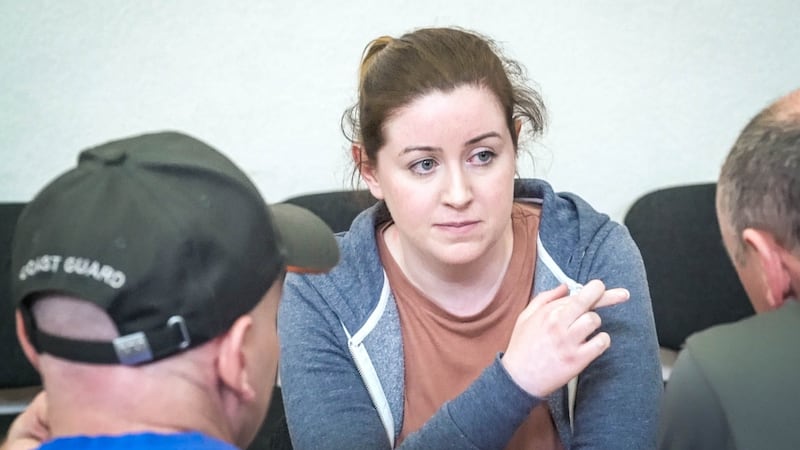“As a pilot, it is difficult to put a winchman onto a deck in rough seas. After you have done it, and when you hold the helicopter back slightly from the deck, you can see the winchman looking up at you.
“You watch the deck rolling, seeing him struggling to hold his footing as waves wash over the deck, seeing him look upwards, and giving a thumbs-up sign. And then being led away by one of the ship’s crew, down into the bowels of the ship, to attend to an injured person . . .
“In rugby, scoring tries is the glamour part, but a big tackle can reverse the flow of the game. So it often was with a winchman and [his] search and rescue crew . . .”
When Dave Courtney documented life as an Air Corps and Irish Coast Guard pilot in his book Nine Lives, he placed skilful emphasis on the role played by those colleagues who were trained to disappear down a wire and retrieve people from a heaving deck, hostile cliff-face or an angry sea.
Winch crew like Paul Ormsby and his colleague Ciarán Smith – both still missing from Rescue 116 – were the first to meet the stranded and injured, the first to administer first aid and emergency medical care.
By their “humour and laughter, toughness and honesty”, Courtney wrote, they could “face challenges and personal danger with a glow”.
Boomeranged
Father of three Ciarán Smith (38) received awards for his courage during his career with the Air Corps and Irish Coast Guard – including a hazardous snatch of a swimmer from a cove below cliffs near Portstewart, Co Derry in May 2003, where he was boomeranged between swell and rocks.
Originally from Swords, Co Dublin and living in Oldtown, the Wild Geese GAA player and cyclist also shared an award with the late Capt Mark Duffy for the difficult rescue of a woman from a cliff near Howth, Co Dublin last year.
His colleague Paul Ormsby was also a highly respected winch operator in both the Air Corps and Irish Coast Guard who participated in many rescues and medical evacuations.

He was commended for his role in a joint Irish Coast Guard helicopter tasking to winch 17 Spanish and Portuguese fishermen from a burning fishing vessel, the Milford Eagle, 150 miles west of Shannon in January 2000.
Though he never sought a management position, Ormsby, from Ballyfermot in Dublin, was acknowledged as being “every bit as capable”, says Courtney, and a consummate professional who recognised that “the ocean has zero regard for your status or your ego”.
Courtney flew more than 300 search-and-rescue flights during his career, and worked with three of the four Air Corps Dauphin helicopter crew who subsequently died in the Tramore, Co Waterford, crash during return from a rescue mission in July, 1999.
He was also one of many former colleagues of the crew of Irish Coast Guard Dublin-based helicopter Rescue 116 who travelled to Blacksod in the days after March 14th to assist the search.
Constant swell
Capt Dara Fitzpatrick (45) was the first confirmed casualty, having been recovered from the sea and administered medical aid in the early hours of that morning.
Her colleague Capt Mark Duffy (51) was located 10 days later in the helicopter cockpit, at a depth of 40 metres off Blackrock island, during the first real calming of constant swell around the rock.
However, equinoctial weather and the exposed location of the crash site have combined to intensify the ordeal for the Ormsby and Smith families, still waiting for news from north Mayo.
An entire community gathered behind them has tried to provide comfort during the long and tortuous wait – from the volunteers with west coast search-and-rescue units who would have known and trained with some, if not all, of the Dublin-based air crew, to the wider coastal constituency which lives with the harsh nature of this part of the Atlantic seaboard.
Josie McGinty and Mary John Tom Breathnach, two of Annette Gallagher’s army of women providing food in Halla Naomh Bhreandáin in nearby Eachléim village, have connections with the Inishkea islands north of Blackrock.
Their parents’ generation would have been among those forced to quit the islands after many of the active fishermen were drowned in 1927 in a violent storm.
And there are more recent memories of fatalities, including club diver Michael Heffernan during a cave rescue in 1997, Belmullet publican Tony Lavelle's son Anthony during a sheep delivery which went wrong in 2001, and 23-year-old Carrowteigue fisherman Daniel Doherty in September 2015.
Sea sweep
Hence the strong emphasis on safety for those participating in the concerted sea sweep this weekend, which has been planned in response to an appeal by Orla Smith, sister of Ciarán Smith, last Monday.

Less than 20 hours earlier, Ms Smith, her sister-in-law Martina and three young children, and her parents Michael and Teresa, had been told that there was no sign of either of the two men under the section of helicopter wreckage lifted from the seabed by salvage tug Ocean Challenger and Naval Service divers.
The Smiths were about to leave Eachléim and face into a harrowing journey back east when they met Caitlín Uí Aodha, chairwoman of the Lost at Sea Tragedies (Last) organisation.
Uí Aodha, a former skipper herself from Helvick, Co Waterford, is the widow of Michael Hayes, one of five men who died in the 2012 sinking of the Tit Bonhomme in west Cork, and one of the last two members of the crew whose bodies were found almost four weeks later.
“So three weeks is still early in a search,” Uí Aodha said, while acknowledging that the helicopter crash site is far more exposed than Glandore harbour, and subject to strong north-south tides, a confluence of currents and constant Atlantic surge and swell.
The record for recovering a body in these waters is 96 days. The two winchmen would be more visible than most at sea, having been wearing immersion suits.
Remotely operated vehicle
Irish Coast Guard operations manager Gerard O’Flynn and Garda superintendent Tony Healy have pledged to continue looking, stating that a Naval Service patrol ship and the Marine Institute’s remotely operated vehicle (ROV) Holland 1 on board Irish Lights ship Granuaile will remain in the area.

However, Orla Smith’s appeal struck a chord with members of the Erris Inshore Fishermen’s Association – eager to help but constrained by the fact that Blackrock Island is both a search site and the subject of official air accident and Garda investigations.
Up to 12 large Killybegs vessels, and dozens of whitefish and inshore boats from up and down the western and southern seaboards, have also offered assistance in the concerted sea survey sweep which sets out from Blackrock island, west of Blacksod Bay, on Saturday at 9am.
The fleet will be supported by Irish Coast Guard air, sea and shore units, by the Naval Service and Air Corps, by the Garda Water Unit, Civil Defence and by RNLI volunteers.
Mayo’s Ballyglass and Achill all-weather lifeboats have already recorded 244 active search hours since the crash, while inshore lifeboat crews from Ballyglass, Sligo and Bundoran have launched up to three times daily since debris was found in Portnoo, Co Donegal.
The RNLI Arranmore island crew has been out for four full days over the past week.
Search plan
The search plan has been drawn up by Malin Head Coast Guard marine rescue co-ordination centre, and involves a grid extending some 56km (35 miles) west, depending on the vessel size.
It will be fuelled by much diesel and more goodwill, generated by the team boiling kettles back in Eachléim, the school pupils who sent cards and donations from around the country, the man who drove through the night to offer a portable cold room, the Dublin chef who spent a weekend cooking, the west of Ireland businesses who sent everything from cakes to toilet rolls, and the Aran islanders who wrote a large cheque.
If nothing is found, the Holland 1 will continue to work the seabed area around the island, and Supt Healy of Belmullet Garda station says he is open to more physical searches on and beneath Blackrock.
If State agencies inevitably have to pull back, the inshore fleet will continue, according to north Mayo fisherman and RNLI crewman Eamon Dixon.
Warmer weather is on the way, there will be more boats at sea, and there is always that sliver of hope.











